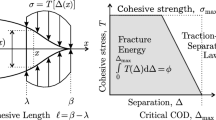Abstract
In the present study, a singular element is proposed to deal with crack propagation problem in which the nonlinear behavior in front of the crack tip is considered. And cohesive zone model (CZM) is used to simulate the nonlinear behavior. At first, a new singular element is constructed and further extended to deal with CZM based cracks. Cohesive tractions act on the cohesive crack surfaces can be approximately expressed in the form of polynomial. Then special solution corresponding to each expanding term is specified analytically so it has strictly satisfied the requirements of both differential equations of interior domain and the corresponding cohesive traction component acting on cohesive crack surface. Then the special solution can be transformed into nodal forces. Based on the situation of that the crack propagation is governed by cohesive laws an efficient iteration procedure is proposed. Finally, the cohesive crack propagation under arbitrary external loading can be simulated. In the present method the hypotheses of CZM are completely satisfied such that stress singularity vanishes and virtual crack length can be measured. And the validity of the present method is illustrated by numerical examples.
















Similar content being viewed by others
References
Barsoum RS (1976) On the use of isoparametric finite elements in linear fracture mechanics. Int J Numer Methods Eng 10:25–37
Barsoum RS (1977) Triangular quarterc-point elements as elastic and perfectlyc-plastic crack tip elements. Int J Numer Methods Eng 11:85–98
de Borst R (2001) Some recent issues in computational failure mechanics. Int J Numer Methods Eng 52:63–95
de Borst R (2003) Numerical aspects of cohesive-zone models. Eng Fract Mech 70:1743–1757
Goudarzi M, Mohammadi S (2015) Analysis of cohesive cracking in saturated porous media using an extrinsically enriched EFG method. Comput Geotech 63:183–198
Henshell R, Shaw K (1975) Crack tip finite elements are unnecessary. Int J Numer Methods Eng 9:495–507
Hu X, Yao W (2011) A novel singular finite element on mixed-mode bimaterial interfacial cracks with arbitrary crack surface tractions. Int J Fract 172:41–52
Hu X, Yao W (2013) A new enriched finite element for fatigue crack growth. Int J Fatigue 48:247–256
Karihaloo BL, Xiao QZ (2008) Asymptotic fields at the tip of a cohesive crack. Int J Fract 150:55–74
Karihaloo BL, Xiao QZ (2010) Accurate simulation of mixed-mode cohesive crack propagation in plain and fibre-reinforced concrete using XFEM. Aedificatio Publ Ltd, Freiburg
Karihaloo BL, Xiao QZ (2010) Asymptotic fields ahead of mixed mode frictional cohesive cracks. ZAMM-Z Angew Math Mech 90:710–720
Li SH, Ghosh S (2006) Extended Voronoi cell finite element model for multiple cohesive crack propagation in brittle materials. Int J Numer Methods Eng 65:1028–1067
Lin K, Tong P (1980) Singular finite elements for the fracture analysis of Vc-notched plate. Int J Numer Methods Eng 15:1343–1354
Luiz Oliveira H, Denner Leonel E (2013) Cohesive crack growth modelling based on an alternative nonlinear BEM formulation. Eng Fract Mech 111:86–97
Remmers JJC, de Borst R, Needleman A (2003) A cohesive segments method for the simulation of crack growth. Comput Mech 31:69–77
Saleh AL, Aliabadi MH (1995) Crack-growth analysis in concrete using boundary-element method. Eng Fract Mech 51:533–545
Tong P, Pian T, Lasry SJ (1973) A hybridc-element approach to crack problems in plane elasticity. Int J Numer Methods Eng 7:297–308
Verhoosel CV, Scott MA, de Borst R, Hughes TJR (2011) An isogeometric approach to cohesive zone modeling. Int J Numer Methods Eng 87:336–360
Xiao QZ, Karihaloo BL (2006) Asymptotic fields at frictionless and frictional cohesive crack tips in quasibrittle materials. J Mech Mater Struct 1:881–910
Yamamoto Y, Tokuda N (1973) Determination of stress intensity factors in cracked plates by the finite element method. Int J Numer Methods Eng 6:427–439
Yao W, Hu X (2011) A novel singular finite element of mixed-mode crack problems with arbitrary crack tractions. Mech Res Commun 38:170–175
Yao W, Hu X (2012a) A novel singular finite element on mixed-mode dugdale model based crack. J Eng Mater Technol 134:021003
Yao W, Hu X (2012b) A singular finite element on the mixed-mode bimaterial interfacial cracks. Int J Comput Methods Eng Sci Mech 13:219–226
Yao W, Zhong W, Lim CW (2009) Symplectic elasticity. World Scientific, Singapore
Zeng D, Katsube N, Zhang J, Soboyejo W (2002) Hybrid crack-tip element and its applications. Finite Elem Anal Design 38:319–335
Zhou F, Molinari J-F (2004) Dynamic crack propagation with cohesive elements: a methodology to address mesh dependency. Int J Numer Methods Eng 59:1–24
Acknowledgments
The work described in this paper was supported by the National Natural Science Foundation of China (No. 11372065).
Author information
Authors and Affiliations
Corresponding author
Rights and permissions
About this article
Cite this article
Yao, W., Zhang, P., Gao, H. et al. An analytical singular element for the study of cohesive zone model based crack propagation. Int J Fract 197, 189–199 (2016). https://doi.org/10.1007/s10704-016-0075-0
Received:
Accepted:
Published:
Issue Date:
DOI: https://doi.org/10.1007/s10704-016-0075-0




